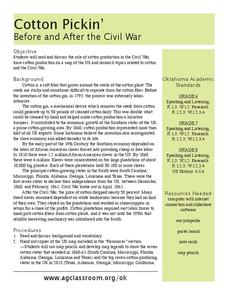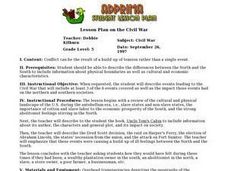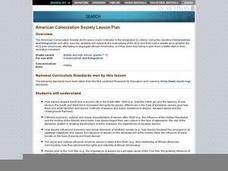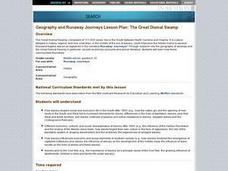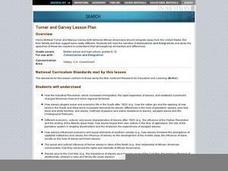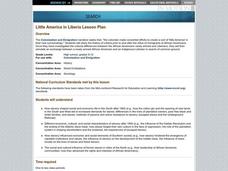National Endowment for the Humanities
Factory vs. Plantation in the North and South
North is to factory as South is to plantation—the perfect analogy for the economy that set up the Civil War! The first lesson plan in a series of five helps teach beginners why the economy creates a driving force for conflict. Analysis...
Curated OER
Kensington Mansion: Plantation, Sharecroppers, Tenants
Eleventh graders investigate the significance of the Kensington Mansion. In this South Carolina history lesson, 11th graders take field trips to the mansion and research primary and secondary sources about plantations, sharecropping, and...
Curated OER
Cotton Pickin' Before and After the Civil War
Students explore the impact of cotton. For this economics lesson, students listen to a lecture presented by their instructor on the Southern crop of cotton and its impact on the South prior to and following the Civil War. Students...
Curated OER
The Antebellum South
Your history students will be on the edges of their seats during this fascinating presentation, which details the abolition movement and slave life during the Antebellum period in the American South. Students will be left agape at the...
Curated OER
Whitewashing Southern History
Students discuss the fact and fiction of slavery in the South. After viewing a video on two New Orleans plantations, they determine the accuracy of the facts presented. In the computer lab, they visit various sites and examine which ones...
Curated OER
Images from South Carolina Cotton Mills
Fifth graders write a paragraph comparing their lives to the lives of a child working in South Carolina during the early 1900's. In this Industrial Revolution lesson plan, 5th graders explore primary and secondary sources to teach them...
Curated OER
Lesson Plan on the Civil War
Fifth graders identify events leading to the Civil War and explain the impact the events had on northern and southern societies.
Curated OER
The Pre-Civil War Era (1815–1850)
In this online interactive U.S. history worksheet, students respond to 9 short answer and essay questions about 19th century America. Students may check some of their answers on the interactive worksheet.
Curated OER
The Underground Railroad
In this United States history activity, students utilize a word bank of 10 terms or phrases to answer 10 fill in the blank questions about the Underground Railroad. A short answer question is included as well.
Curated OER
The Civil War 1850–1865
For this online interactive history worksheet, students respond to 10 short answer questions about the American Civil War. Students may check some of their answers on the interactive worksheet.
Curated OER
A Nation Divided: Why Couldn't They Just Get Along?
Fourth graders examine both perspectives of the Civil War as related to the differing economies. In this nation divided lesson, 4th graders view primary sources, examine paper money and a political chart, and review recruitment posters.
Curated OER
American Colonization Society Lesson Plan
Students read an article online "Colonization and Emigration" and break into debating groups. They research points that support their side, namely whether or not the American Colonization Society was for or against segregation. They...
Curated OER
Denmark Vesey's Rebellion
Young scholars research the slave, Denmark Vesey, and create a dramatic play depicting his life.
Curated OER
Civil War and Reconstruction
Learners examine the differences between the North and South during the pre-Civil War era. In this Civil War era lesson plan, students spent 7 days looking at things that were different between the Union and Confederate state before the...
Curated OER
Slavery in the United States
Students investigate the personal accounts of slaves in the United States. They participate in various activities according to grade level to examine the role of slavery in the South.
Curated OER
THE GREAT DISMAL SWAMP
Learners analyze how slavery shaped social and economic life in the South after 1800, the different economic, cultural, and social characteristics of slavery after 1800, and slavery both prior and after the Civil War.
Curated OER
Heaven, Hell, and Baltimore
This lesson plan allows students to research and compare the city of Baltimore to other northern cities of interest during the Great Migration. After reading a narrative entitled Return South Migration and conducting extensive research,...
Curated OER
Home Ties
Students explore the reasons people choose to migrate including political, economic and familial motivations. They interview family members and compare their ancestors own reasons for migration to those of African American urban migrants.
Curated OER
Slavery in the Antebellum South
Students discuss Stephen Foster's depiction of slavery. Using the internet, they discover what the life of a slave was really like in the antebellum South. As a class, they discuss contemporary arguments for and against slavery.
Curated OER
Differences in Location Lesson Plan: Treatment of Early African Americans
Students reach The Domestic Slave Trade, then examine the differences between the people enslaved in North America as opposed to those in Brazil.
Curated OER
Forest Joe Lesson Plan: Outlaw or Hero?
Students become familiar with an American legend that is unfamiliar to many. Presented with the legend of Forest Joe, a runaway slave who, much like Robin Hood, stole from the rich to give to the poor, students draw comparisons and...
Curated OER
African American Emigration: Turner and McNeal
Learners discuss reasons why African Americans may have wanted to emigrate from the United States followig the Civil War. They complete a Venn diagram noting the differences between proposals by Marcus Garvey and Henry McNeal Turner.
Curated OER
Little America in Liberia
Students study the history of Liberia prior to and after the influx of immigrants of African Americans. They investigate the cultural differences between the African Americans and newly-arrived Liberians.
Curated OER
Mixing Races in New Orleans
Students discuss the changes in the legal, social, and political status of African Americans and those of mixed ethnicity after reading the narrative, Haitian Immigration: Eighteenth and Nineteenth Centuries.




